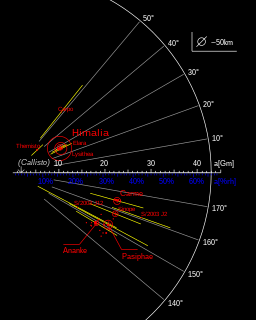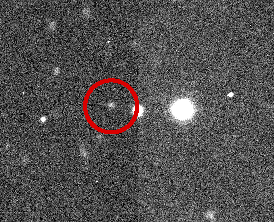Philophrosyne, also Jupiter LVIII, originally known as S/2003 J 15, is a natural satellite of Jupiter. It was discovered by a team of astronomers from the University of Hawaii led by Scott S. Sheppard, et al. in 2003. [1] [2]

A natural satellite or moon is, in the most common usage, an astronomical body that orbits a planet or minor planet.

Jupiter is the fifth planet from the Sun and the largest in the Solar System. It is a gas giant with a mass one-thousandth that of the Sun, but two-and-a-half times that of all the other planets in the Solar System combined. Jupiter has been known to astronomers since antiquity. It is named after the Roman god Jupiter. When viewed from Earth, Jupiter can be bright enough for its reflected light to cast shadows, and is on average the third-brightest natural object in the night sky after the Moon and Venus.

The University of Hawaiʻi system is a public, co-educational college and university system that confers associate, bachelor's, master's, and doctoral degrees through three university campuses, seven community college campuses, an employment training center, three university centers, four education centers and various other research facilities distributed across six islands throughout the state of Hawaii in the United States. All schools of the University of Hawaii system are accredited by the Western Association of Schools and Colleges. The U.H. system's main administrative offices are located on the property of the University of Hawaiʻi at Mānoa in Honolulu CDP.
Jupiter LVIII is about 2 kilometres in diameter, and orbits Jupiter at an average distance of 22,721 Mm in 699.676 days, at an inclination of 142° to the ecliptic (142° to Jupiter's equator), in a retrograde direction and with an eccentricity of 0.0932.

The ecliptic is the mean plane of the apparent path in the Earth's sky that the Sun follows over the course of one year; it is the basis of the ecliptic coordinate system. This plane of reference is coplanar with Earth's orbit around the Sun. The ecliptic is not normally noticeable from Earth's surface because the planet's rotation carries the observer through the daily cycles of sunrise and sunset, which obscure the Sun's apparent motion against the background of stars during the year.
It belongs to the Pasiphae group, retrograde irregular moons that orbit Jupiter between 22.8 and 24.1 Gm, at inclinations of roughly 150-155°.

The Pasiphae group is a group of retrograde irregular satellites of Jupiter that follow similar orbits to Pasiphae and are thought to have a common origin.
The moon was lost following its discovery in 2003. [3] [4] [5] [6] It was recovered in 2017 and given its permanent designation that year. [7]
